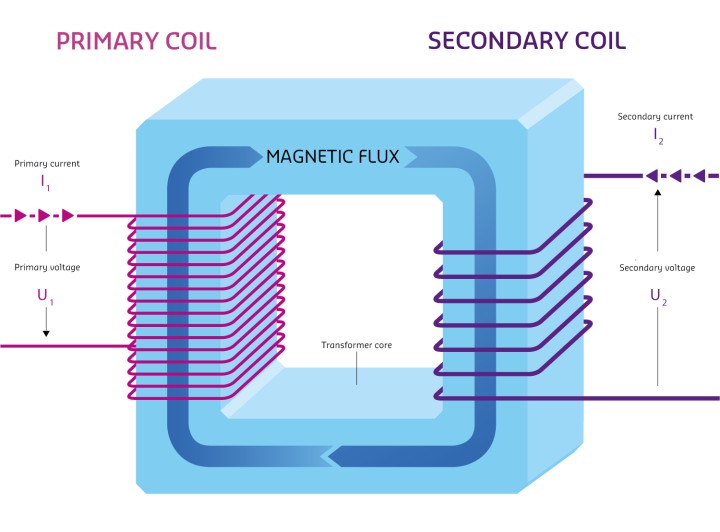Transformer

AC systems have proven themselves to be highly effective for transmitting electrical energy over longer distances – and there are some good reasons for this: AC power can be stepped up to a higher or stepped down to a lower voltage level with very little loss with the aid of transformers. A high voltage level offers the advantage that larger amounts of electrical energy can be transmitted through the power lines with relatively low currents and correspondingly lower losses.
The transformers in our substations step down the voltage from, for instance, 380 to 220 or 110 kilovolts. Distribution system operators then transport the electricity at this voltage level onwards, further stepping down the voltage in stages to the level required by the customer, such as 230 volts.
Design of a transformer: a steel core with multiple coils
The heart of the transformer is a core made of thin steel laminations stacked in layers, each lamination insulated from its neighbour by a thin, non-conducting insulation layer. This core forms a magnetic circuit. A transformer also comprises at least two windings or “coils”. These are wires that are wrapped around the steel core, with each coil having a different number of turns.
These transform the primary (input) voltage into a secondary (output) voltage in proportion to the number of turns. In the case of large transformers, the coils are immersed in a tank filled with oil. This oil both insulates and cools the windings. The heat is dissipated via cooling fins or cooling systems. The current is input through bushings, which ensure insulation between the current connection and the transformer tank. The largest transformers currently in operation have an apparent power capacity of up to 600 megavolt-amperes (MVA) and weigh up to 450 metric tons.

How a transformer works
As soon as a current flows in the primary coil (which has a lot of windings), a magnetic flux is initiated in the core. This induces a voltage in the secondary coil. However, as this coil has fewer windings than the primary coil, the current that flows here is higher, but the voltage is lower. The product of current (I) and voltage (U), and therefore the apparent power, is identical for both coils.
In other words, the current is reduced by the same factor as the voltage is increased. In the coil with the greater number of windings, the current flow is lower, while the voltage is higher; in the coil with fewer windings, the current flow is higher and the voltage lower.